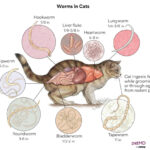As true cat aficionados, we never miss an opportunity to admire felines that resemble majestic wild animals like tigers, leopards, lions, and bobcats. If you dream of experiencing a touch of the wild every day, right in your living room, consider adopting one of these Exotic Domestic Cats. These breeds offer all the cuddles and companionship of a domestic cat, with a striking, untamed appearance that’s sure to turn heads.
Toyger Bengal Ocicat Cheetoh Egyptian Mau Highlander Savannah Serengeti Bombay Abyssinian Chausie American Bobtail Kurilian Bobtail Manx Pixie-bob
Key Considerations for Exotic Cat Breeds
Before you get swept away by the allure of these unique felines, it’s important to understand that owning an exotic domestic cat can be a distinct experience compared to traditional house cats. These breeds, while domesticated, often retain some traits from their wilder ancestors, requiring specific attention to their needs.
Legalities and Regulations
Bringing an exotic-looking cat into your home involves more than just choosing a name. Legal aspects are crucial, especially for breeds like the Savannah cat, which has recent wild ancestry.
In many regions, particularly in the U.S., Savannah cats and similar breeds with close wildcat lineage are subject to regulations. For instance, Savannah cats are often permitted as pets only when they are several generations removed (typically four or more) from their African serval ancestors. These regulations are in place to ensure both public safety and the welfare of the animals.
Beyond breed-specific laws, housing restrictions can also apply. Apartment complexes or homeowner associations may have rules about pet sizes or breeds due to concerns about behavior or safety. Therefore, thorough research into local, state, and housing-specific regulations is essential before welcoming an exotic domestic cat into your family. This proactive approach helps avoid potential legal complications and ensures a smooth transition for your new feline companion.
Activity Levels and Enrichment Needs
Exotic domestic cats are not just about striking looks; they are also known for their dynamic personalities and high energy levels. Their wild ancestry contributes to a natural curiosity and a need for both physical and mental stimulation that surpasses that of many domestic breeds.
These cats thrive on interaction and exploration. Expect to engage in frequent play sessions with interactive toys that mimic hunting, such as wand toys or puzzle feeders. Providing climbing structures like cat trees and shelves is also vital to satisfy their natural urge to climb and survey their territory. For breeds like Bengals and Chausies, leash training can be an excellent way to provide safe outdoor adventures and further enrich their lives.
Mental enrichment is equally critical. Puzzle toys that dispense treats, training sessions using positive reinforcement, and even cat-friendly apps on tablets can keep their intelligent minds engaged and prevent boredom-related behavioral issues. A stimulated exotic domestic cat is a happy cat, less likely to resort to destructive behaviors and more likely to form a strong, positive bond with their human family. Preparing to meet these activity and enrichment needs is key to responsible ownership of these captivating breeds.
Litter Box Considerations and Hygiene
When it comes to bathroom habits, exotic domestic cats can have particular preferences and needs. Often larger than standard domestic cats, breeds like Savannahs or Chausies require appropriately sized litter boxes to ensure comfort and hygiene. A large litter box is not just a recommendation, but a necessity for these bigger breeds.
Cleanliness is paramount for most cats, and exotic breeds are no exception. Frequent cleaning is a must to maintain a sanitary environment and encourage consistent litter box use. Some exotic domestic cats may also be particular about the type of litter used. Experimenting with different textures and scents (or unscented varieties) might be necessary to find the perfect match for your feline’s preferences. Due to their size and activity levels, they may also use the litter box more frequently, necessitating more regular litter changes and overall maintenance to keep their space clean and inviting. Addressing these litter box considerations proactively contributes significantly to your exotic cat’s comfort and your home’s hygiene.
Cats That Resemble Tigers
Toyger
 Toyger exotic cat breed
Toyger exotic cat breed
The Toyger, a breed name playing on “toy” and “tiger,” perfectly embodies its appearance with striking orange and black stripes. Despite their tiger-like looks, Toygers have no wild ancestry. This breed originated in the 1980s from crossing a Bengal with a striped Domestic Shorthair, aiming to create a domestic cat that resembled a miniature tiger.
Weighing up to 15 pounds, the Toyger is a medium-sized cat, a manageable “pocket tiger” for your home. Their temperament is far from ferocious; they are known for being friendly, affectionate, and playful companions. Toygers are also intelligent and trainable, often enjoying learning tricks, further enhancing their appeal as engaging pets. If you’re captivated by the tiger’s majestic appearance but desire a purely domestic temperament, the Toyger is an ideal choice among exotic domestic cats.
Cats That Resemble Leopards
Bengal
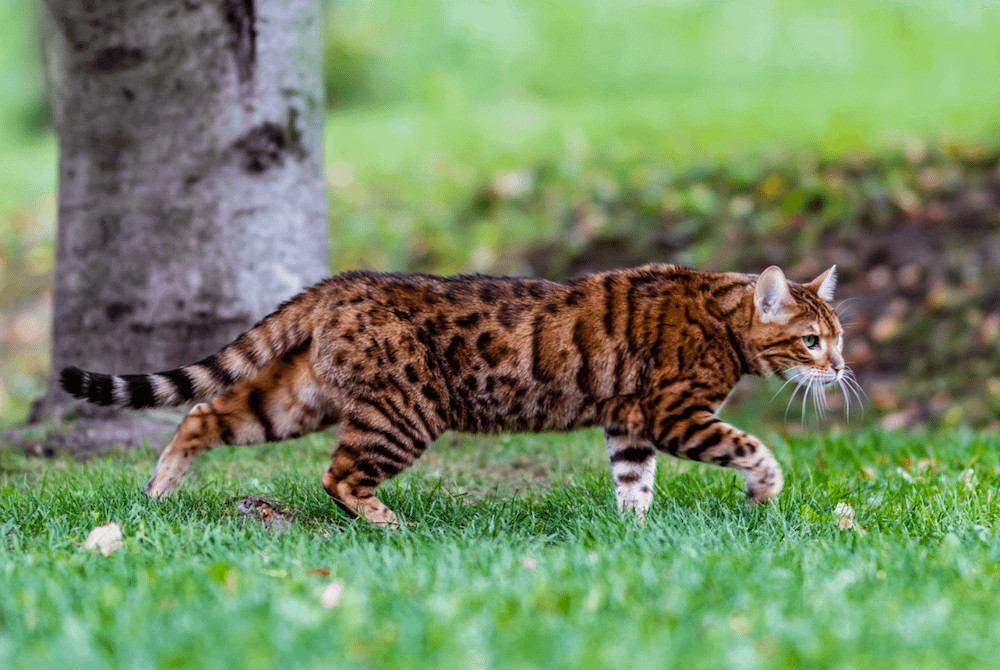 Bengal exotic cat breed
Bengal exotic cat breed
The Bengal cat stands out with its genuine touch of the wild, being a hybrid breed resulting from crossing an Asian Leopard Cat with domestic shorthairs. This lineage gives Bengals their distinctive spotted or marbled coats, reminiscent of leopards, along with a captivating, energetic personality.
Bengals are medium to large cats, weighing up to 18 pounds, with a muscular build that reflects their athleticism. They are exceptionally intelligent, curious, and active cats that thrive on interaction. Known for their love of water and playful nature, Bengals can be trained to perform tricks and even walk on a leash, offering an engaging and dynamic pet ownership experience. Their devotion to their families makes them wonderful companions for those ready to match their energy and provide ample attention and playtime. For an owner seeking an exotic domestic cat with a touch of the wild in both looks and personality, the Bengal is a compelling choice.
Ocicat
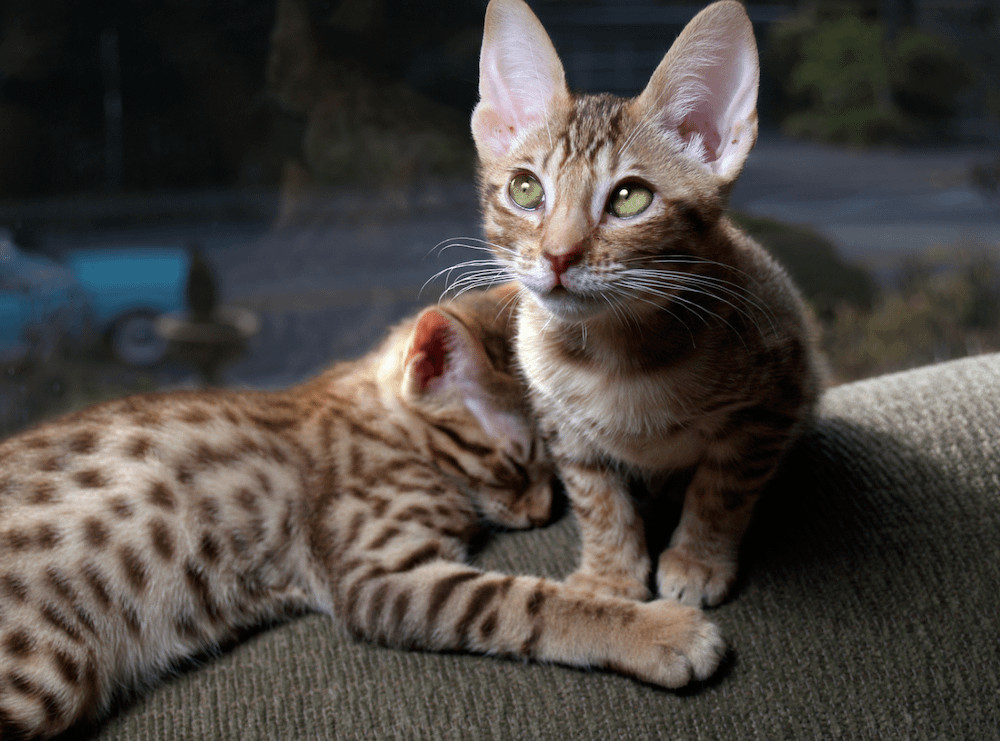 Ocicat exotic cat breed
Ocicat exotic cat breed
The Ocicat, despite its wild-looking spots, is entirely domestic, developed through selective breeding to resemble wild cats like ocelots—hence the name. Interestingly, the breed’s creation in the 1960s was accidental, emerging from efforts to breed Siamese cats with Abyssinian points. Breeders continued to refine the Ocicat, introducing American Shorthairs to expand their coat color range.
Ocicats are medium-sized, weighing up to 15 pounds, and boast a robust, athletic build. Their coats feature striking spots in various colors, with the tawny spotted variety most closely resembling a leopard. Temperamentally, Ocicats are known for being friendly, outgoing, and devoted to their families. They are energetic and enjoy being involved in household activities, making them interactive and engaging companions. For those drawn to the leopard’s spotted beauty but desiring a purely domestic and affectionate cat, the Ocicat is an excellent representative of exotic domestic cats.
Cheetoh
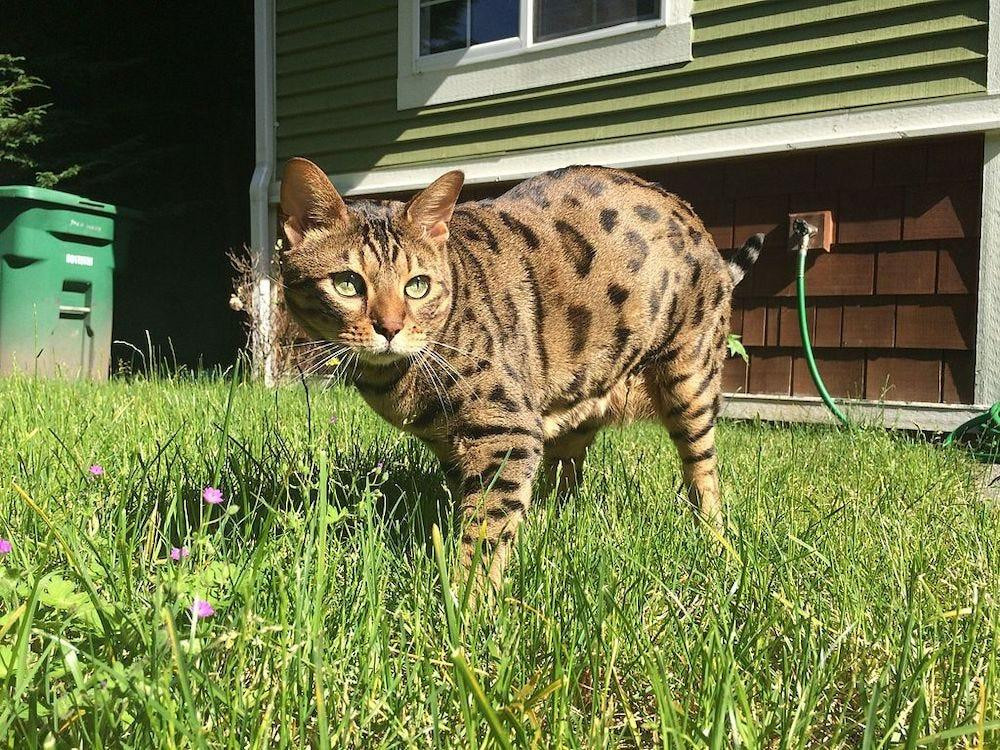 Cheetoh exotic cat breed
Cheetoh exotic cat breed
The Cheetoh cat is a relatively new and rare breed, intentionally developed to resemble a cheetah in size and appearance, while maintaining a domestic temperament. Originating from crossing Bengals and Ocicats, Cheetohs inherit the striking spotted coats and muscular builds of their parent breeds, enhancing the wild cat aesthetic.
Cheetohs are large and substantial cats, weighing up to 20 pounds or more, giving them an imposing presence reminiscent of their wild namesake. Despite their cheetah-like appearance and stalking gait, they are known for being affectionate, playful, and sociable companions. Cheetohs are also intelligent and trainable, often enjoying leash walking and interactive play. As one of the newer and rarer exotic domestic cats, the Cheetoh offers a unique opportunity to own a cat that truly embodies the look of a small cheetah, combined with a loving domestic nature.
Egyptian Mau
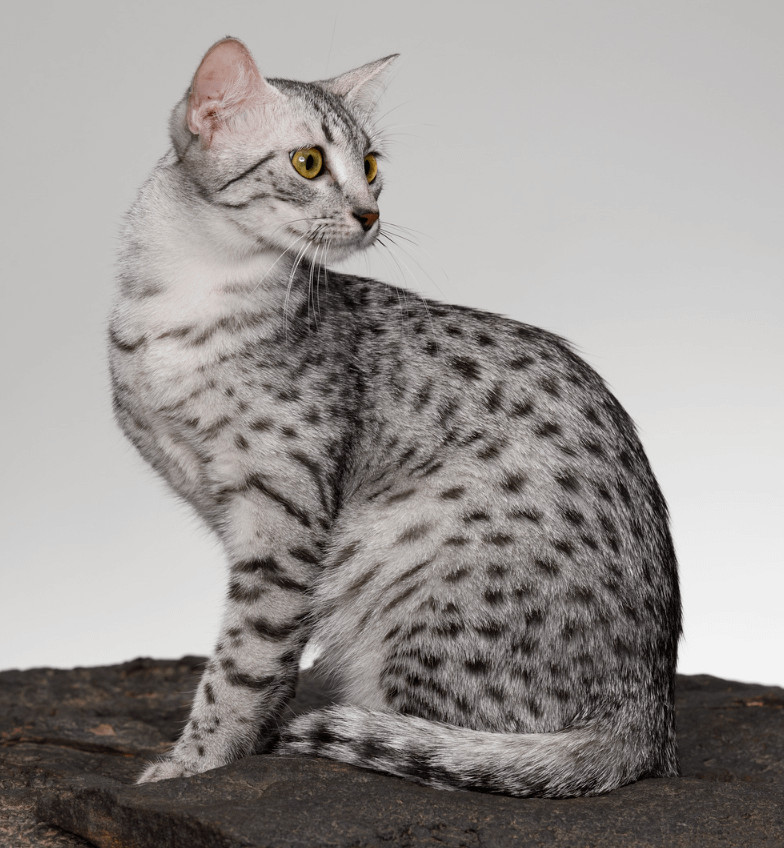 Egyptian Mau exotic cat breed
Egyptian Mau exotic cat breed
The Egyptian Mau holds a special place among exotic domestic cats as the only naturally spotted domestic breed. Their spots are not the result of selective breeding but occur naturally, adding to their unique appeal and historical significance. Considered one of the oldest domestic cat breeds, Egyptian Maus are believed to be direct descendants of cats revered in ancient Egypt, as depicted in ancient Egyptian art.
Egyptian Maus are medium-sized, known for their elegant appearance and athletic build, capable of impressive speeds up to 30 mph. Their coats feature naturally occurring spots in various colors, often with a shimmering quality. Temperamentally, they are devoted, intelligent, and active, forming strong bonds with their families. The name “Mau” itself is the Egyptian word for cat, underscoring their ancient connection to Egypt. For those fascinated by history and seeking a naturally spotted, athletic, and loyal feline, the Egyptian Mau is a remarkable choice among exotic domestic cats.
Highlander
 Highlander exotic cat breed
Highlander exotic cat breed
The Highlander cat is a distinctive breed that combines the exotic look of a wild cat with unique physical traits, including curled ears and a naturally bobbed tail. Developed from crossing the Desert Lynx and Jungle Curl breeds, Highlanders exhibit a striking appearance with marbled or spotted coats reminiscent of leopards, further enhanced by their lynx-like bobbed tails and curled ears.
Highlanders are medium to large cats, weighing up to 20 pounds, with a sturdy build. They are known for their playful, energetic, and affectionate personalities, making them engaging family pets. Despite their somewhat wild appearance, Highlanders are purely domestic and enjoy interacting with their human companions. Their unique combination of exotic markings, curled ears, and bobbed tails makes them a visually striking and captivating breed within the realm of exotic domestic cats.
Savannah
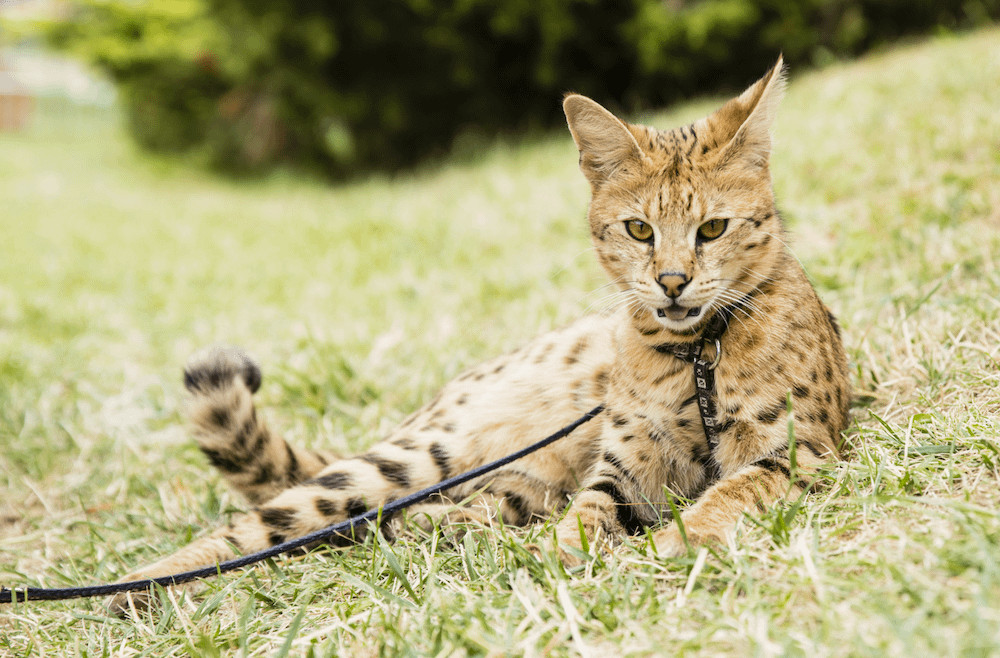 Savannah exotic cat breed
Savannah exotic cat breed
The Savannah cat is perhaps the most overtly exotic among exotic domestic cats, owing to its recent ancestry from the African serval, a medium-sized wild cat. This hybrid breed embodies a wild appearance with its tall, slender build, large ears, and striking spotted coat patterns inherited from the serval.
Savannahs are large and athletic cats, with sizes varying greatly depending on the generation (filial generation or F-number), with earlier generations being significantly larger and retaining more serval traits. They are known for their high energy levels, intelligence, and adventurous nature. Savannahs require experienced owners who can provide ample space, enrichment, and understanding of their unique needs. While fiercely loyal to their families, their strong hunting instincts may pose challenges in households with smaller pets. Ownership of Savannah cats often comes with legal considerations and regulations due to their wild ancestry, making them a breed for highly committed and informed owners seeking a truly exotic feline companion.
Serengeti
 Serengeti exotic cat breed
Serengeti exotic cat breed
The Serengeti cat is a breed specifically developed to resemble the African serval, but without any actual serval ancestry. This breed achieves its wild appearance through selective breeding of Bengals and Oriental Shorthairs, resulting in a cat with a spotted coat, long legs, and large ears, mirroring the elegant look of a serval.
Serengeti cats are medium-sized, weighing up to 15 pounds, known for their graceful and athletic build. They are energetic, playful, and intelligent cats that form close bonds with their families. While they may initially be shy, they quickly adapt and become affectionate companions. Serengetis are also known for their impressive jumping ability, capable of leaping up to 7 feet. For those captivated by the serval’s appearance but seeking a purely domestic cat with a lively and engaging personality, the Serengeti is a remarkable choice among exotic domestic cats.
Bombay
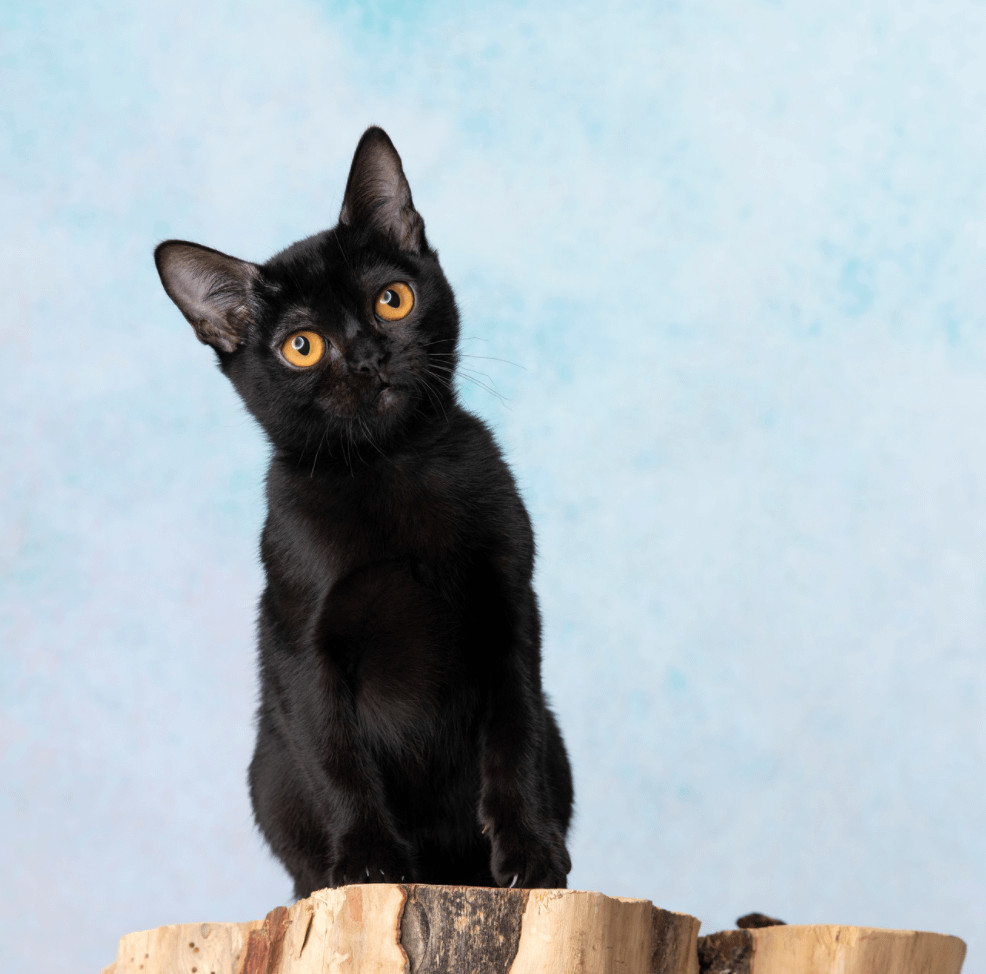 Bombay exotic cat breed
Bombay exotic cat breed
The Bombay cat is often described as a “parlor panther” or “mini-panther” due to its striking resemblance to a black leopard or panther. Developed to resemble a Burmese cat but with a sleek, jet-black coat and captivating copper eyes, the Bombay exudes a sophisticated and exotic charm. The breed’s name pays homage to Bombay, India, the “land of the black leopard,” further emphasizing its panther-like aesthetic.
Bombay cats are medium-sized, weighing up to 15 pounds, with a muscular and elegant build. They are known for their friendly, affectionate, and outgoing personalities, often greeting family and visitors alike. Bombay cats are also playful and intelligent, enjoying games and interaction. If you are drawn to the sleek beauty of a black panther and desire a loving, people-oriented companion, the Bombay cat is an excellent representative of exotic domestic cats.
Cats That Resemble Lions
Abyssinian
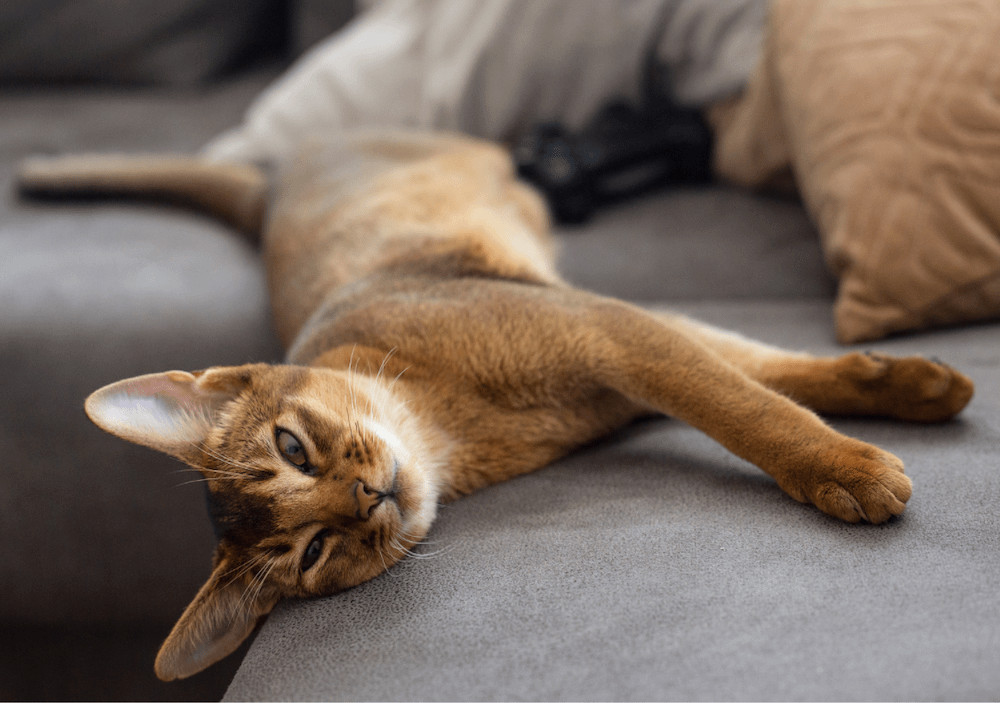 Abyssinian exotic cat breed
Abyssinian exotic cat breed
The Abyssinian cat, one of the oldest known cat breeds, is often likened to a miniature mountain lion or cougar due to its elegant, ticked tabby coat and lithe build. Originating possibly from ancient Abyssinia (now Ethiopia), this breed boasts a regal and refined appearance that evokes the image of a small wildcat.
Abyssinians are medium-sized but slender and muscular, weighing between 7 and 10 pounds. Their ticked tabby coat, where each hair is banded with different colors, creates a unique and shimmering effect that contributes to their wildcat look. Temperamentally, Abyssinians are known for being intelligent, curious, and active cats. They are affectionate but not overly demanding of lap time, preferring to interact and play. For those who appreciate the elegant, wild appearance of a mountain lion in a manageable domestic cat, the Abyssinian is a distinguished choice among exotic domestic cats.
Chausie
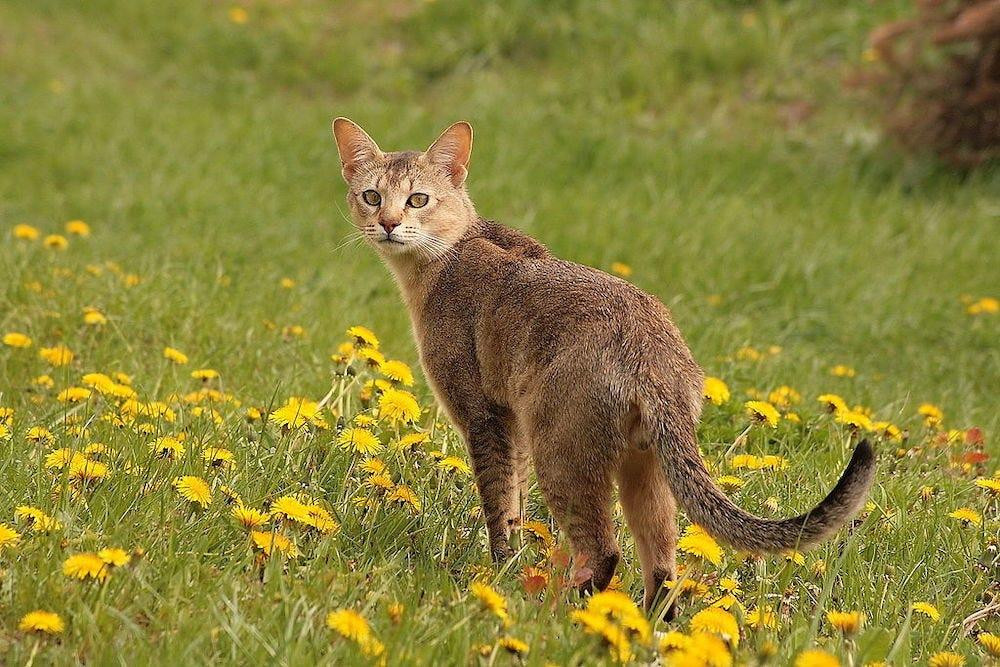 Chausie exotic cat breed
Chausie exotic cat breed
The Chausie cat stands out among exotic domestic cats due to its direct lineage from the Jungle Cat (Felis chaus), a wildcat species. This close wild ancestry gives Chausies a distinctly untamed appearance, reminiscent of a small lion or mountain lion, combined with a robust, athletic build. “Chausie” itself is derived from “Felis chaus,” the Jungle Cat’s Latin name, highlighting this direct connection.
Chausies are large and powerful cats, weighing up to 25 pounds, with a substantial and muscular physique. They are known for their energetic, intelligent, and confident personalities. Chausies require experienced owners who can provide ample space, activity, and understanding of their unique needs stemming from their wild heritage. They are often described as dog-like in their loyalty and trainability, enjoying leash walking and interactive play. For those seeking a truly exotic and substantial feline companion with a strong link to the wild, the Chausie is a compelling, albeit demanding, choice.
Cats That Resemble Bobcats
American Bobtail
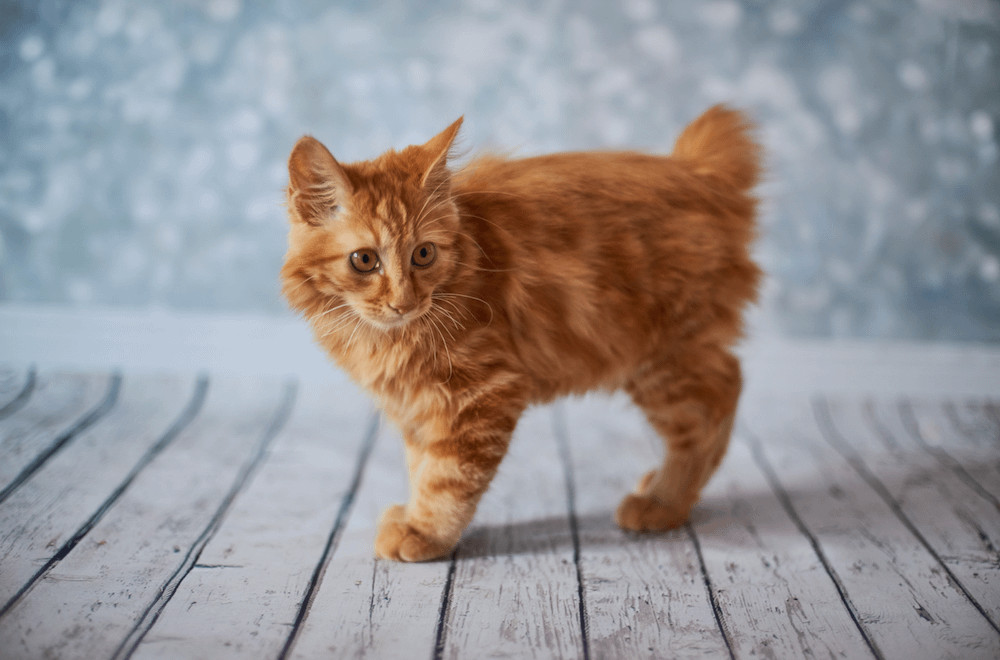 American Bobtail exotic cat breed
American Bobtail exotic cat breed
The American Bobtail cat is named for its most distinctive feature: a naturally short, bobbed tail, which gives it a striking resemblance to a bobcat. This breed developed naturally in the American Southwest, where the bobbed tail was likely a beneficial trait for survival. Despite their wild appearance, American Bobtails are fully domestic and known for their gentle and affectionate nature.
American Bobtails are medium to large cats, weighing up to 16 pounds, with a sturdy and muscular build. They are slow to mature, reaching full size around 2-3 years old. Known for their adaptability and friendly temperament, American Bobtails make excellent family pets, often described as dog-like in their loyalty and playfulness, even enjoying games of fetch. For those charmed by the bobcat’s rugged appearance but seeking a gentle and devoted domestic companion, the American Bobtail is a wonderful choice among exotic domestic cats.
Kurilian Bobtail
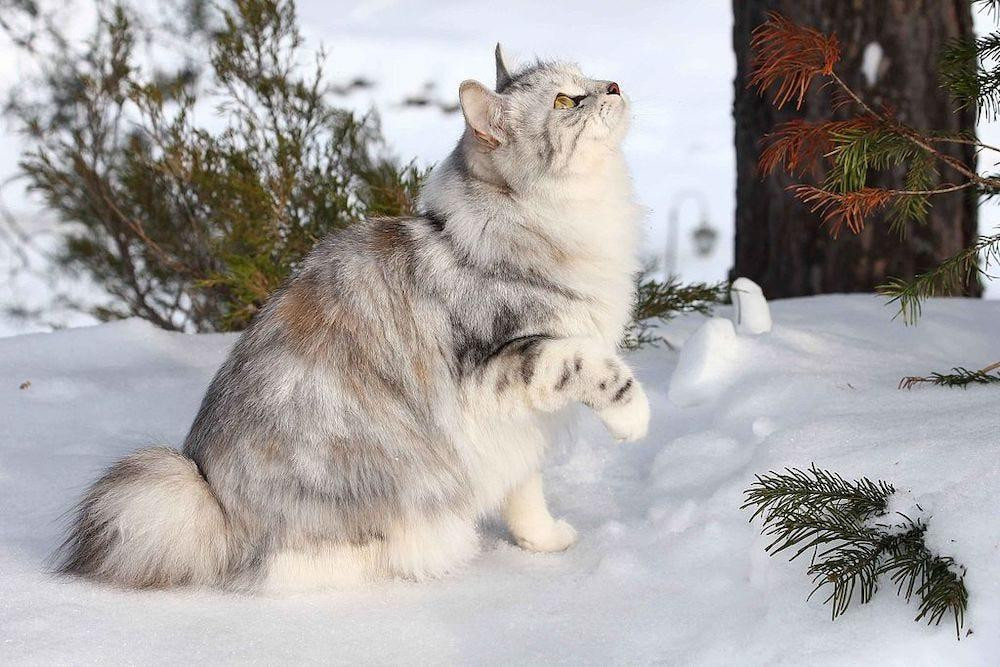 Kurilian Bobtail exotic cat breed
Kurilian Bobtail exotic cat breed
The Kurilian Bobtail is another bobtailed breed, originating from the Kuril Islands and Sakhalin Island of Russia. This natural breed developed in relative isolation, resulting in a distinctive appearance with a short, fluffy, “pom-pom” tail, reminiscent of a lynx or bobcat. Kurilian Bobtails are relatively uncommon outside of their native regions, adding to their exotic appeal.
Kurilian Bobtails are medium to large, muscular cats. They are known for their gentle, sociable, and playful personalities. Interestingly, they often have an affinity for water, unlike many domestic cats. Kurilian Bobtails are also known to be excellent mousers and affectionate lap cats, combining practicality with companionship. For those seeking a unique and naturally bobtailed cat with a gentle and playful nature, the Kurilian Bobtail is a captivating and less common example of exotic domestic cats.
Manx
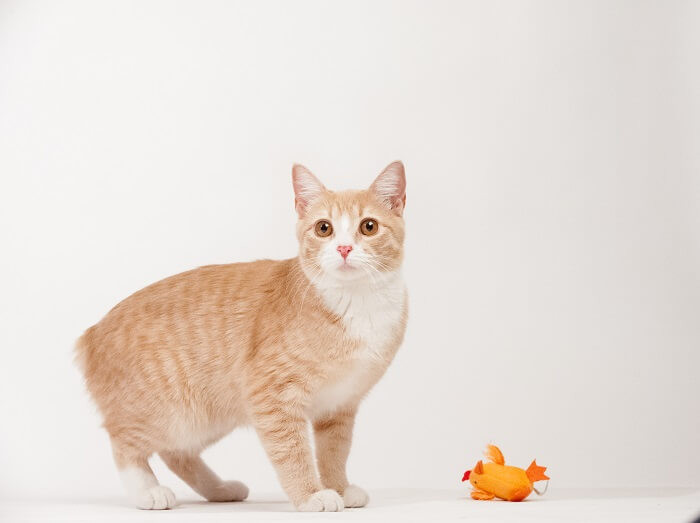 Manx exotic cat breed
Manx exotic cat breed
The Manx cat is famous for its lack of a tail, or having a significantly shortened tail, a genetic mutation that originated on the Isle of Man. This tailless or stub-tailed appearance, combined with their rounded body and rabbit-like gait, can give some Manx cats a subtle resemblance to a bobcat, although this is less pronounced than in breeds specifically developed for bobcat looks.
Manx cats are medium-sized and sturdy, known for their robust health and hunting skills, developed from their origins as island mousers. They are typically affectionate and people-oriented cats, forming strong bonds with their families. However, it’s crucial to be aware that the tailless gene in Manx cats can be associated with serious health issues, particularly spinal problems. If considering a Manx, adoption from a reputable rescue organization is recommended to avoid supporting unethical breeding practices that prioritize extreme taillessness over cat health. While Manx cats possess a unique look, responsible ownership and awareness of potential health issues are paramount.
Pixie-bob
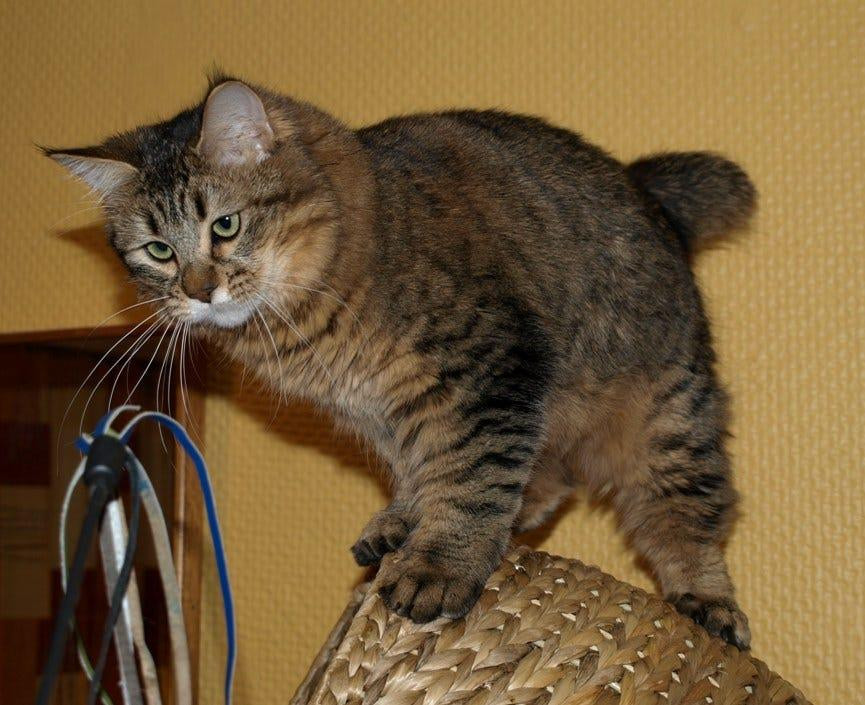 Pixiebob exotic cat breed
Pixiebob exotic cat breed
The Pixie-bob is a breed intentionally developed to resemble the North American bobcat, with a naturally occurring short tail, a sturdy build, and often a wild-looking, tabby coat pattern. Despite legends suggesting bobcat ancestry, the Pixie-bob is purely domestic, with breeders selectively emphasizing natural bobtail mutations and bobcat-like features.
Pixie-bobs are medium to large cats, with some males reaching impressive sizes. They are known for their gentle, playful, and often dog-like personalities, being trainable and devoted to their families. Pixie-bobs are also unique as the only breed that accepts polydactylism (extra toes) as a breed standard, further adding to their distinctive traits. For those captivated by the bobcat’s wild appearance and seeking a gentle, family-friendly companion with a touch of the exotic, the Pixie-bob is a popular and charming choice among exotic domestic cats.
Have you been enchanted by these exotic domestic cats? Remember, beyond their striking appearances, they are domestic animals needing loving homes. Consider visiting your local animal shelter or rescue organization – you might find your own exotic-looking feline friend waiting for you!
And if you’re ready to welcome one of these stunning cats into your life, be sure to check out our guide on adopting a cat to ensure you are fully prepared for pet parenthood!
Photo credits:
- Toyger: © Heikki Siltala / Wikimedia Commons / CC-BY-SA-3.0
- Cheetoh: © Chris Rue / Wikimedia Commons / CC-BY-SA-4.0
- Highlander: © DigitalDirt / Wikimedia Commons / CC-BY-SA-4.0
- Chausie: © Wilczakrew / Wikimedia Commons / CC-BY-SA-3.0
- Kurilian Bobtail: © TRUE KURILIANS / Wikimedia Commons / CC-BY-SA-4.0
- Pixie-bob: © Donna Cox / Wikimedia Commons / CC-BY-3.0
[

